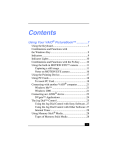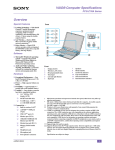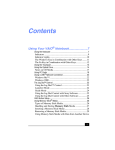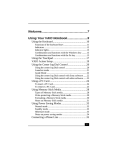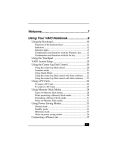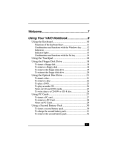Download Sony PCG-C1VPK User's Manual
Transcript
Contents Using Your VAIO® PictureBook™ .............7 Using the Keyboard.....................................................7 Combinations and Functions with the Windows Key ........................................................9 Indicators .....................................................................9 Indicator Lights .........................................................10 Combinations and Functions with the Fn Key ..........10 Using the built-in MOTION EYE™ camera ............11 Capturing a still image .........................................11 Notes on MOTION EYE camera .........................16 Using the Pointing Device.........................................17 Using PC Cards .........................................................18 To insert PC Card.................................................18 Connecting with another VAIO® computer..............21 Windows Me™ ....................................................21 Windows 2000 .....................................................21 Connecting an i.LINK® device .................................22 DVgate™ Applications ........................................24 The Jog Dial™ Control .............................................25 Using the Jog Dial Control with Sony Software..27 Using the Jog Dial Control with Other Software .27 Internal Timer.......................................................28 Using Memory Stick® Media....................................28 Types of Memory Stick Media ............................28 1 Change to Current Document Title VisualFlow........................................................... 30 VAIO Action Setup .................................................. 32 Connecting Peripheral Devices ...............33 Connecting a Phone Line .......................................... 34 Connecting a USB Printer......................................... 35 Connecting a USB Mouse......................................... 36 Connecting an External Display ............................... 37 Using the Floppy Disk Drive (optional) ................... 40 Connecting an Optical Drive (optional).................... 43 Notes on CD and DVD Discs .............................. 46 Connecting External Speakers .................................. 47 Connecting an External Microphone ........................ 47 Recording from a Microphone or Audio Equipment 48 Switching the connector functionality ................. 48 Expanding Your Notebook Capabilities ................... 51 Personal Digital Assistant.................................... 51 The Wireless LAN Access Point ......................... 51 The Wireless LAN PC Card ................................ 52 Displaying the Sony Notebook Setup Screen ........... 53 Sony Notebook Setup Tabs ................................. 54 Controlling Power Management ............................... 55 Viewing the Power Management status icons ..... 55 CPU Information ................................................. 56 Power Management Profiles................................ 57 Power Management Commands .......................... 59 2 Conserving Battery Power ...................................59 Displaying Battery Information ................................61 Battery Icon Descriptions.....................................61 Displaying Detailed Battery Information.............62 Changing the Window Design of Sony Software 63 Selecting the Display Mode ......................................64 Using the Dual Display function (Windows Me only) ..................................................66 Selecting Dual Display mode...............................66 Setting the colors and resolution for each display67 Customizing the virtual desktop...........................67 Releasing the Dual Display setting ......................67 About the Software on Your Notebook ...69 Overview ...................................................................70 MovieShaker™ .........................................................75 Importing Images and Sound Clips......................75 Creating a Movie using Shaker ............................75 Editing Clips and Scenes......................................76 Saving a Movie ....................................................78 PictureGear™ ............................................................79 Managing Your Pictures ......................................79 Creating a Photo Album.......................................79 Using Panorama Maker........................................80 Making Still Images and Panoramic from MPEG ... 80 OpenMG™ Jukebox 2.0............................................81 3 Change to Current Document Title Electronic Music Distribution (EMD) Services .. 81 Starting OpenMG Jukebox 2.0 ............................ 82 Recording a CD ................................................... 84 Transferring Songs (Check-in/Check-out) .......... 85 Check-out............................................................. 85 Check-in............................................................... 86 Notes on using Portable Players .......................... 87 Notes on performing the System Restore function of System Tools on Windows® Millennium Edition87 Additional Features.............................................. 88 Software Support Information .................................. 89 Sony Service Center ............................................ 90 Getting Help...............................................93 Support Options ........................................................ 93 VAIO Support Agent .................................95 Using the Quick Fix Wizard ..................................... 95 Using Common Solutions ......................................... 97 About Automatic Updates ........................................ 98 Update Notification ............................................. 99 VAIO Support Agent Properties........................ 100 Using Support Central ............................................ 101 Troubleshooting......................................105 Troubleshooting your Notebook ............................. 106 Troubleshooting the LCD screen....................... 109 4 Troubleshooting the mouse and pointing device110 Troubleshooting drives, PC Cards and peripheral devices................................................................111 Troubleshooting software...................................113 Troubleshooting the modem ..............................114 Troubleshooting audio .......................................114 Troubleshooting Memory Stick media...............115 5 Change to Current Document Title 6 VAIO® Notebook Quick Start Using Your VAIO® PictureBook™ 1 This section describes how to use the keyboard, MOTION EYE™ camera, Pointing Device, PC Cards, Jog Dial Control, Memory Stick media, and optional floppy disk and optical drives. You will also find information on how to connect your PictureBook to another computer or i.LINK device. Using the Keyboard Your keyboard is very similar to a typewriter’s, but your notebook keyboard has additional keys that perform specific computer-related tasks. Keyboard Escape key Print Screen key Function keys Correction keys ~ Shift key Shift key + Ctrl key Fn key Numeric keypad area Alt key Windows® key 7 Applications key Navigation keys VAIO® Notebook Quick Start Key Description Numeric keypad area Contains the keys found on a typical calculator. Use the numeric keypad area to type numbers or to perform mathematical calculations such as addition and subtraction. Numbers appear on the front beveled edge of the numeric keys. Note that you must press the Num Lock key to activate the numeric keypad. (When you do so, the Num Lock light will be on.) Several keys are devoted to moving the cursor on the screen (the four arrow keys which also function as the Home, End, Page Up, and Page Down keys). The Insert, Backspace, and Delete keys enable you to make corrections in your documents. The twelve function keys along the top of the keyboard are used to perform designated tasks. For example, in many applications, F1 is the Help key. The task associated with each function key may vary from one application to the next. The Esc (Escape) key is used to cancel commands. The Print Screen key takes an electronic snapshot of the screen and places it in the Windows Clipboard. You can then paste the screen shot into a document and print it. Several keys are always used with at least one other key: Ctrl, Alt, and Shift. When held down with another key, the Ctrl (Control) and Alt (Alternate) keys offer another way to give commands. For example, in many applications, instead of choosing the Save command from a menu, you can hold down Ctrl and press S (referred to as Ctrl+S). The Shift key operates the same way as on a typewriter; it’s used to produce capital letters or special symbols such as @ and $. The key with the Windows® logo displays the Windows® Start menu; it’s the equivalent of clicking the Start button on the task bar. See “Combinations and Functions with the Windows Key” on page 9. The Fn key is used in combination with other keys to issue commands. The Fn keys at the left and right sides both work the same. See “Combinations and Functions with the Fn Key” on page 10. The Applications key displays a shortcut menu of context-sensitive choices; pressing this key is the equivalent of clicking the right mouse button. Navigation keys Correction keys Function keys Escape key Print Screen key Operator keys (Shift, Ctrl, Alt keys) Windows® key Fn key Applications key 8 Combinations and Functions with the Windows Key Combinations and Functions with the Windows Key Combination Function + F1 + Tab Displays Windows Help. Switches the selected button on the taskbar. +E +F Displays Windows Explorer. Displays the Windows Find: All Files window to find a file or folder. This is the equivalent of selecting Find and then Files or Folders from the Start menu. Displays the Windows Find: Computer window where you can locate other computers. This is the equivalent of selecting Find and then Computer from the Start menu. Minimizes all displayed windows (with Num Lock off). Returns all minimized windows to their previous size. Displays the Run window. This is the equivalent of selecting Run from the Start menu. Displays the Properties window. This is the equivalent of double-clicking the System icon in the Control Panel. + Ctrl + F +M Shift + +R Fn + +M + Insert Indicators Indicator Function Power Power on: lights green. Standby mode: flashes umber. Battery Indicates the status of the battery inserted in the computer. Hard disk Lights when data is read from or written to the hard drive. Do not enter Standby mode or turn off the computer when this indicator light is on. 9 VAIO® Notebook Quick Start Indicator Lights Light On Off Memory Stick Data is read from or written to the Memory Stick. (Do not enter Standby mode or turn off the computer when this indicator light is on.) Turns on when the number keys area in the numeric keypad are active. Turns on when the letters appear in uppercase as you type. The Shift key lowers the case of typed letters when Caps Lock is on. Turns on when the screen scrolls differently. (Does not work with all applications.) The Memory Stick is not being accessed. Num Lock Caps Lock Scroll Lock Turns off when the alphanumeric character keys in the keypad area are active. Turns off when letters appear in lower case as you type (unless you hold down the Shift key). Turns off when information moves across the display normally. Combinations and Functions with the Fn Key Combinations/ Feature Functions Fn+ (ESC) Standby Puts the system into Standby mode, a power management state. To return the system to the active state, press any key or press the power switch on your computer. Toggles the built-in speaker off and on. Fn+ (F5) Brightness control Adjusts the built-in speaker volume. To increase volume, press Fn+F4, then or . To decrease volume, press Fn+F4, then or . Adjusts the brightness of the LCD. To increase light intensity, press Fn+F5 and then or . To decrease light intensity, press Fn+F5 and then or . Toggles through the LCD, external display (connected to the Monitor connector), and both LCD and external display. Fn+ (F3) Speaker switch Fn+ (F4) Speaker volume Fn+ (F7) Switch to the external display Only LCD LCD and external display Only external display 10 Using the built-in MOTION EYE™ camera Combinations/ Feature Functions Fn+ the TV Toggles through LCD display and dual LCD/TV. / (F8) Switch to LCD and TV only LCD Fn+ (F12) Hibernate Fn+D Video standby Fn+B Bass Boost Provides for the lowest level of power consumption. When you execute this command, the state of the system and state of the peripheral devices are written to the hard disk and the system power is turned off. To return the system to the original state, use the power switch to turn on the power. Turns off the LCD in order to save power. To return the LCD to an active state, press any key (Windows Me only). Toggles the bass-boost function off and on. This feature is available only while using the headphone. ✍ Some functions are not available until Windows launches. Using the built-in MOTION EYE™ camera Your computer includes a built-in MOTION EYE camera. You can use the camera to shoot still images and record video clips. Capturing a still image 1 Press the CAPTURE button to start Smart Capture. CAPTURE Button 11 VAIO® Notebook Quick Start 2 Select Still Viewer/Long Movie Player/Net Movie Player from the application list. 3 Choose Still by clicking the on-screen Capture Mode button. To switch to Motion, click the on-screen Change Capture Mode button. (You can also use Jog Dial to control this function.) 4 The Finder window appears. Turn the MOTION EYE camera lens toward the subject you want to photograph. Turning MOTION EYE 12 Using the built-in MOTION EYE™ camera 5 Adjust the focusing ring. Adjusting the Focusing Ring 6 Half-press the CAPTURE button on the computer. The image remains still for a few seconds. To display another image, release the CAPTURE button and press again. 7 Fully press the CAPTURE button. The still viewer window opens and the captured still image appears in the still viewer window. 8 For more detailed information about the capture software, refer to the online Help for Smart Capture. ✍ If you turn the lens toward you, Smart Capture goes into mirror mode. You can use the mirror mode to take a still image of yourself. A mirror-image appears in the finder window of the display while shooting; however, after capturing, a normal image appears. You can capture the following still image sizes: 640 × 480, 320 × 240, 160 × 120, and 80 × 60 pixels. ✍ You can adjust the sound quality for different sound environments. Click Start, point to Settings, and then point to Control Panel. Click Sounds and Multimedia and then Audio tab. Click Volume under the Sound Recording category. Adjust the volume level with the microphone slider. 13 VAIO® Notebook Quick Start Using the Self-timer You can take a still image 10 seconds after clicking the CAPTURE button by using the self-timer. 1 Click Still Viewer/Movie Player from the switch applications list. 2 Select Still mode. 3 Click the Options button. The Still Image Options dialog box appears. 4 Click Self-timer capture on the Capturing mode tab. 5 Click OK. ✍ After Self-timer capture is complete, the capturing mode changes automatically to single image (Normal Capture). To stop Self-timer, click the CAPTURE button. To display the remaining time before the picture is taken, turn on the capture information display. The capture information display can be turned on and off by selecting Displaying Capture Information from the shortcut menu. To create a panoramic image You can create panoramic images by connecting still images captured with the MOTION EYE camera. 1 Capture the still images. Using the panoramic-assist function of Smart Capture, capture still images to be used to create your panoramic image. For details, see Smart Capture online Help. 2 Start the PictureGear software. For details, see the PictureGear section in this manual. To set the image quality and mode of MOTION EYE camera You can change the settings of image quality or mode of MOTION EYE camera. 1 Click the Start button, point to Settings, and then click Control Panel. 2 Double-click the MOTION EYE camera icon. The Camera Control Utility appears. 14 Using the built-in MOTION EYE™ camera ✍ 3 You can also activate the Camera Control Utility using the Jog Dial control. Camera Control Utility is available even while using other software applications that use the MOTION EYE camera. Click the Image tab and drag the slider to the left or the right. The level settings increase as the slider is moved to the right and decrease as it is moved to the left. Features Description Brightness Contrast Hue Color Sharpness Adjust the brightness Adjust the contrast of the light part and the dark part Adjust the hue of the color Adjust the coloring Adjust the sharpness 4 Click Mode tab and click the item you want to set. Features Description White balance Adjust the colors to be more natural. Auto: Adjust automatically to natural colors. Indoor: Suitable for indoor capturing. Outdoor: Suitable for outdoor capturing. Hold: Suspend the proximate settings of the white balance, so that settings do not change automatically. Set the shutter speed: Auto: Adjust the shutter speed automatically. 1----50 : This speed is suitable for capturing images under fluorescent light. Hold: Suspend the proximate settings of the shutter speed, so that settings do not change automatically. Shutter speed ✍ The appropriate mode will vary depending on the situation or subject. Switching between outdoor and indoor environments while setting the White Balance to Hold may cause colors to appear incorrectly. For color correctness, set White Balance to Auto and capture something white, and then wait approximately 10 seconds. The image should now display with the correct color. 5 Click OK. ✍ Click the Default button, and then click OK to return all settings to the default settings. 15 VAIO® Notebook Quick Start Notes on MOTION EYE camera ❑ Do not touch the camera lens. ❑ Do not point the camera toward the sun. ❑ You cannot detach the camera. ❑ Smart Capture is unavailable while other software that uses the built-in camera is in use. Close all software that uses the built-in camera before you use Smart Capture. ❑ You cannot transfer still images or video clips from the built-in camera while transferring to connected i.LINK devices. ❑ You should take an initial shot before taking a final shot to ensure sound and picture quality. ❑ Your recording is not guaranteed. ❑ If your recording fails due to conditions unfavorable to the camera, the contents of your recording cannot be guaranteed. ❑ Clean the lens regularly. Picture quality is adversely affected when the lens is dirty. ✍ MOTION EYE camera can also be used with the Microsoft® NetMeeting® application. For more information about the Microsoft® NetMeeting® application, open the Start menu, point to Programs, Accessories, Communications, and then click NetMeeting. 16 Using the Pointing Device Using the Pointing Device The pointing device on the keyboard allows you to point to, select, drag, and scroll objects on the screen. Using the Pointing Device Pointer Pointing device Right button Left button Center button Action Description Point Press the pointing device in a direction to place the pointer on an item or object. Press the left button once. Press the left button twice. Press the right button once. In many applications, this action displays a shortcut menu of context-sensitive choices. Press the pointing device in a direction to place the pointer on an item or object. While holding the left button, press the pointing device in a direction, and then release it at the desired point. Press the pointing device while pressing the center button. Click Double-click Right-click Drag Scroll ✍ The scroll function is available only with applications that support a scroll pointing device feature. Pressing the pointing device too hard may damage it. 17 VAIO® Notebook Quick Start To replace the pointing device cover You can take off the pointing device cover and replace it with the additional cover supplied with your computer. Replacing the Pointing Device Cover Pointing device cover (supplied) ✍ Make sure the cover is tightly secured to prevent damage to the screen when you close the computer. Using PC Cards Your computer includes a PC Card slot. PC Cards allow you to connect portable external devices, such as a CD-ROM drive, or to connect to a network using a PC network Interface Card. ✍ The PC Card slot can accommodate a Type II PC Card. This slot is compatible with Card Bus. Type III PC Cards are not supported. To insert PC Card ✍ You do not need to shut down the computer before inserting or removing a PC Card. 18 Using PC Cards 1 Insert the PC Card into the PC Card slot with the front label facing up. Gently push the Card into the slot until it is fixed into the connector; the release button comes out. Inserting PC Card Insert in the direction of the arrow. 2 Press the release button down and toward the ventilation slot. Release Button Release button Release button 19 VAIO® Notebook Quick Start ✍ Do not force a Card into the slot. It may damage the connector pins. If you have difficulty inserting a PC Card, check that you are inserting the PC Card with the correct orientation. See the manual that came with your PC Card for more information on its use. When a PC Card is inserted, do not place your computer in a bag or case. Pressure or shock to a PC Card may damage your computer. To remove a PC Card ✍ Follow the procedure below when you remove the PC Card while your computer is on. Failure to follow this procedure may result in a malfunction. If your computer is turned off, you do not have to follow these instructions. 1 Double-click in the task tray. 2 The “Unplug or Eject Hardware” dialog displays. 3 Select the hardware device you wish to remove by clicking it. 4 Click Stop. 5 Confirm the correct device is selected in “Stop a hardware device.” 6 The message, “PC Card can now be safely removed from the system” appears. Click OK. 7 Pull the release button so that it is extended. 8 Press the release button toward the computer. 9 Gently grasp the PC Card and pull it out. 10 Insert the PC Card slot protector into the empty slot. 20 Connecting with another VAIO® computer Connecting with another VAIO® computer Windows Me™ You can connect your VAIO PictureBook to another VAIO computer that has the preinstalled Windows Me operating system or the Sony Smart Connect 3.0 software preinstalled. You may use an optional i.LINK®* cable to connect the two systems and then use one computer to edit, copy, or delete files on the other computer. You can also print from a printer that is attached to either computer. Select the STD mode in Smart Connect 3.0 software to connect with another computer that has Windows Me preinstalled. Connecting with an i.LINK cable i.LINK cable (optional) Windows 2000 The preinstalled Smart Connect software enables you to use an optional i.LINK® cable to connect your VAIO PictureBook to another VAIO computer that also has Smart Connect or preinstalled Windows Me. You can then use one computer to edit, copy or delete files on the other computer. You can also print from a printer attached to either computer. See Smart Connect online Help for more information. * i.LINK is a trademark of Sony used only to designate that a product contains an IEEE1394 connection. The i.LINK connection may vary, depending on the software applications, operating system and i.LINK compatible devices. All products with an i.LINK connection may not communicate with each other. Please refer to the documentation that came with your i.LINK compatible device for information on operating conditions and proper connection. Before connecting i.LINK compatible PC peripherals to your system, such as a CD-RW or hard disk drive, confirm their operating system compatibility and required operating conditions. 21 VAIO® Notebook Quick Start ✍ When you connect two VAIO computers, you must assign each computer a unique name. The computers can be identified by this unique name when the two computers are networked together. ✍ If you have previously purchased a VAIO computer or notebook that does not have the Windows Me operating system or Smart Connect 3.0 software preinstalled, consult the Sony website for support options (http://www.sony.com/pcsupport). Connecting an i.LINK®* device The VAIO C1 PictureBook includes an i.LINK S400 (IEEE1394) connector, which you can use to connect to an i.LINK enabled digital camcorder. To connect a digital camcorder ❑ Plug one end of an i.LINK cable into the S400 connector on the left side of the computer and the other end into the DV In/Out connector on the digital camcorder. * i.LINK is a trademark of Sony used only to designate that a product contains an IEEE1394 connection. The i.LINK connection may vary, depending on the software applications, operating system and i.LINK compatible devices. All products with an i.LINK connection may not communicate with each other. Please refer to the documentation that came with your i.LINK compatible device for information on operating conditions and proper connection. Before connecting i.LINK compatible PC peripherals to your system, such as a CD-RW or hard disk drive, confirm their operating system compatibility and required operating conditions. 22 Connecting an i.LINK® device Connecting a Digital Camcorder to DV In/Out to S400 Digital camcorder i.LINK cable (optional) Notes on connecting an i.LINK device ❑ i.LINK cables that are compatible with your VAIO® C1 PictureBook Computer include cables with the following part numbers: Length Connector Part Number 1.5 meter 1.5 meter 4-pin connector at each end 4-pin connector at one end and 6 pin connector at the other end 4-pin connector at each end VMC-IL4415A VMC-IL4615A 0.8 meter VMC-IL4408A ❑ The Sony digital camcorder is pictured; your digital camcorder may need to be connected differently. ❑ On Sony digital camcorders, connectors labeled “DV In/Out” or “i.LINK” are compatible. ❑ See the manual that came with your digital camcorder for more information on installation and use. 23 VAIO® Notebook Quick Start ❑ The i.LINK connector does not supply power to external devices. If the external device requires power from the i.LINK connector, you cannot use the device with your computer. ❑ The C1 PictureBook supports transfer rates up to 400 Mbps; however, the actual transfer rate is limited to the maximum transfer rate supported by the external device. If multiple devices are connected, the transfer rate will be the lowest maximum transfer rate for the connected devices. ❑ The i.LINK features available may vary depending on the software applications you use. See the documentation that came with your software for more information. DVgate™ Applications Digital Video Captures If your system displays the message, “Failed to record to DV deck, please check deck’s power status, cable connection…,” while you are recording images to a digital video device using DVgate software, close all open applications, and restart your computer. Frequent recording of images to a digital video device while using DVgate may cause this situation to occur. For more information on DVgate software, see the DVgate online help. Adjusting Image Resolution If the images on the LCD do not display smoothly, the resolution may not be set correctly. To check the resolution, click the Setup button in the DVgate Motion-Monitor window. Point to Settings, and then select Low Resolution. The settings you change in this menu affect the images in the monitor window only. Movie data imported to your hard drive and images recorded to DV devices will not be affected. Hard Disk Drive Partition In order to improve the performance of your notebook’s DVgate™ Motion software, the hard disk drive on your notebook has been formatted with two partitions, C and D. The C partition hold 40 percent and the D partition holds 60 percent of the entire drive capacity. DV gate saves files tot he D partition. This prevents large video capture from consuming the available space on your C partition. To maintain optimum performance of DVgate, you should defragment or format the D partition regularly. 24 The Jog Dial™ Control To defragment a partition Before you begin to defragment a partition, make sure you back up all files that you want to save. ❑ Click the Start button in the Windows® taskbar. ❑ Click Programs, Accessories, System Tools, and then click Disk Defragmenter. The Disk Defragmenter window appears. Select the drive you want to defragment from the list, and click the Defragment button. See Windows® Help for more information on defragmenting. The Jog Dial™ Control Your computer is equipped with a Jog Dial control on the right side of the unit. The Jog Dial control enables you to open an application, folder, or document from a predefined list by rotating and pressing the Jog Dial control. In addition, when you press the Jog Dial control, you can turn on your computer automatically and start the selected application or document. Using the Jog Dial Control Jog Dial control The Jog Dial control window always appears in the display. It is either in the launcher mode or in the guide mode. 25 VAIO® Notebook Quick Start Using the Jog Dial™ Control This section explains how to use the Jog Dial control. For information on how to change the Jog Dial control’s settings, right-click the Jog Dial control icon in the task tray and click Help Topics. Launcher Mode The Jog Dial control window is in launcher mode until a software application is launched or the Jog Dial control window becomes active. When an arrow is displayed next to an item in the Jog Dial control window, you can display a submenu of that item by selecting it and pressing the Jog Dial control button. Using Launcher Mode To use the Jog Dial control, click the Jog Dial control window or the Jog Dial control icon in the task tray. Alternatively, you can press the Jog Dial control while pressing the Ctrl key on the keyboard to switch to the launcher mode. 1 Turn the Jog Dial control to select the item you want, then press the Jog Dial control. The window switches to the guide mode, and shows the Jog Dial’s function. JOG Guide Dialog Box 2 Turn or press the Jog Dial control to use the desired function. 3 To select another item, switch to the launcher mode and repeat from step 1. 26 The Jog Dial™ Control Guide Mode The Jog Dial control window is in the guide mode when software is in use and the software window is active. Depending on the software you are using, you can select items from the displayed list using the Jog Dial control. Some Sony software applications have two modes in List View, Simple Menu, and Full Menu. You can switch the mode by pressing the Shift key while turning the Jog Dial control. Using Guide Mode The Jog Dial control window displays the Jog Dial’s function. Using the Jog Dial Control with Sony Software If Sony software that supports the Jog Dial control is active, you can use the Jog Dial’s functions that are allocated to that software. For more information on functions allocated to software, see the software applications online Help. Using the Jog Dial Control with Other Software If the software you are using does not support the Jog Dial control, you can still perform the following functions: Action Description Maximize Window* Press the Jog Dial control button to maximize the size of the active window. Press again to return to normal window size. Press the Jog Dial control button to minimize the size of the active window. Press again to return to normal window size. Press the Jog Dial control button to close the active application. Press the Jog Dial control button to begin scrolling within the active window. Press the Jog Dial control button to re




























































































































